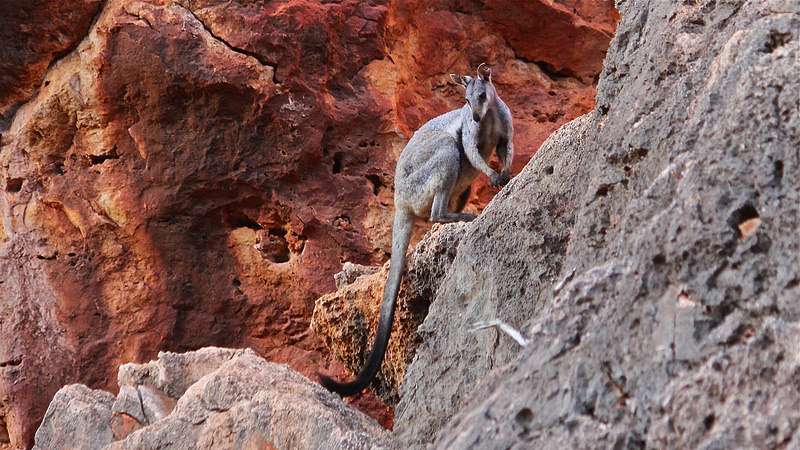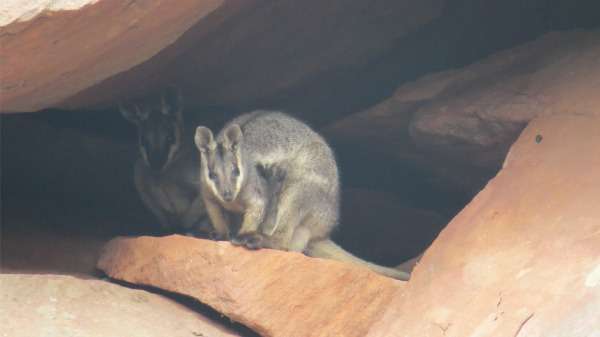Black-flanked rock-wallabies are grey with striking black and white stripes and they have black facial markings and live in rocky environments. Credit: Matt Francey
The WA nature conservation community is abuzz with excitement with the rediscovery of black-flanked rock-wallabies (Petrogale lateralis lateralis) in Kalbarri National Park after two decades of presumed local extinction.
Rock climber Remi Vignals photographed a male and female wallaby with pouch young while visiting the park in August and he sent the images to a Department of Parks and Wildlife ranger.
Mr Vignals thought he may have photographed a tammar wallaby (Macropus eugenii) but the ranger was delighted to see the animals were in fact black-flanked rock-wallabies.
Tammars have different physical characteristics in that they are a rufous-grey colour without side stripes, have a pale face and occur in heathlands.
However, black-flanked rock-wallabies are grey with striking black and white stripes and they have black facial markings and live in rocky environments.
Kalbarri National Park senior ranger Mike Paxman says the photo and video leave no doubt as to the species of rock-wallaby.
He says the wallabies were last sighted in the park around 20 years ago by Dr Jack Kinnear, a now-retired researcher with the department.
"We'd always thought they could still be there but to have it confirmed was a very pleasant surprise," Mr Paxman says.
"It really justifies all the work we've been doing, with ongoing fox baiting since 1996 and goat control since 2006.
One of the photos taken by Remi Vignals of the black-flanked rock-wallabies in Kalbarri National Park. Credit: Remi Vignals
"But at present all we know is that we have one male and one female with pouch young. They look healthy but other than that we don't know much more."
The discovery has sparked a quest for fresh information with scientists already visiting the park to further study the animals.
They have placed remote-sensor cameras in habitat where the wallabies were sighted.
They will set out special traps to capture the animals. These traps are baited with apples, lucerne and other goodies.
Once captured the animals will be measured, a genetic sample taken and then the rock-wallabies will be released.
Mr Paxman says DPaW had been planning to translocate black-flanked rock-wallabies from Wheatbelt populations to the national park.
But now they will first seek to better understand the genetic relationships of the Kalbarri population to the other widely distributed populations of the black-flanked rock-wallaby before releasing any new animals.
The discovery will also further justify plans to introduce the new Eradicat bait to Kalbarri National Park, to control cat numbers.
Black-flanked rock-wallabies occur in isolated populations scattered across WA and their numbers have been decimated by foxes and cats.
Provided by Science Network WA
This article first appeared on ScienceNetwork Western Australia a science news website based at Scitech.

























